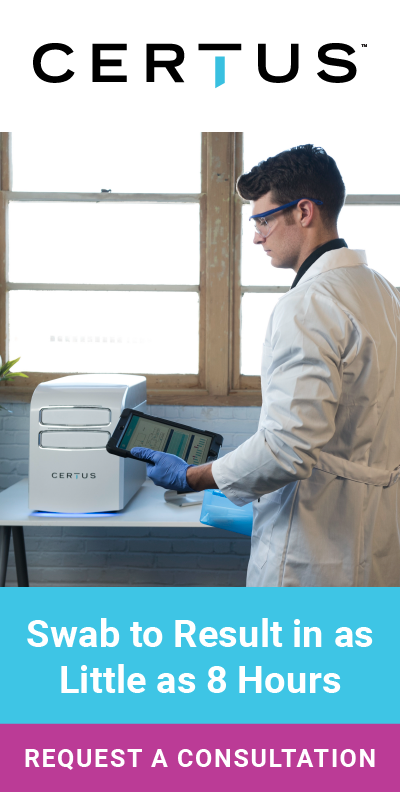Editor’s note: This is part of a series on food safety costs for businesses. The series is sponsored by CERTUS Food Safety. This piece explores different pathogen testing methods for environmental monitoring.
As food safety regulations have improved and increased within the last decade, a technology boom has given the industry access to more accurate and efficient pathogen testing methods, says Erin Crowley, chief scientific officer for Q Laboratories Inc.
“This has been a welcome development for our industry, but it can be overwhelming to navigate through the different types and their various workflows,” Crowley explains.
While some pathogen testing methods, otherwise known as assays, are designed to give rapid results in the matter of a few hours, others can take days to process. However, depending on what is being sampled (also referred to as an analyte) and what pathogen it is being analysed for, each assay has an important place in an environmental monitoring program.
Crowley outlined four common pathogen testing methods.
1. Immunoassay
“Immunoassays are based on the principles that specific antigens will stimulate very specific (unique) immune responses and that the proteins produced by the immune response – called antibodies – can be used to signal the presence of a target compound in a sample,” explains Crowley.
According to her, there are two types of immunoassays: sandwich and competitive.
Sandwich assays use two antibodies to bind a specific target. One antibody is typically immobilized to a solid support such as nitrocellulose membranes found in lateral flow test strips. This can also be done with a microtiter plate which allows for specific antibody collection, commonly referred to as the ELISA (enzyme linked immunosorbent) test. Each test operates on a visual reporter system, with a lateral flow test signalling pathogen presence with line intensity, explains Crowley. Enzymes used for an ELISA test will catalyze a reaction, changing the solution a different color on the microtiter plate, allowing for an optical density assessment.
 Recently a new real time rapid pathogen detection system has been introduced based on Surface Enhanced Raman Spectroscopy (SERS) technology. SERS generates signals that are measured in the near infrared wavelengths where absorption of complex samples such as food is minimal.
Recently a new real time rapid pathogen detection system has been introduced based on Surface Enhanced Raman Spectroscopy (SERS) technology. SERS generates signals that are measured in the near infrared wavelengths where absorption of complex samples such as food is minimal.
“The amount signal produced is directly proportional to the amount of antibody sandwich formation that occurs. By adding known amounts of a specific sample to a detection system and measuring the amount of signal produced, a standard curve can be produced,” she explains. “When a sample containing an unknown amount of analyte is tested, the result can be compared to the standard curve and the amount of analyte in the unknown sample can be quantitated. A plate reader may be used to perform quantitation of ELISA tests.”
When analytes are too small to be sandwiched, competitive assays are used to detect the presence of a specific antigen with only one antibody.
“In competitive assays, analyte in the sample competes with analyte attached to a solid support (lateral flow test strip) or enzyme (ELISA) for the antibody binding site. In competitive assays, the darker the line or greater the optical density the lesser the concentration of analyte in the sample,” says Crowley.
2. Polymerase Chain Reaction (PCR)
“PCR is defined as a technique in molecular genetics that permits the analysis of any short sequence of DNA, or RNA – even in samples containing minute quantities of DNA or RNA. By incorporating a thermocycler, PCR is used to reproduce (amplify) selected sections of DNA or RNA for analysis,” she explains. “A thermocycler heats and cools the DNA in pre-defined cycles, aiding in the amplification.”
In the past, amplification of DNA involved cloning the segments of interest into vectors for expression in bacteria and took weeks. However, conducting PCR in test tubes or reaction tools has whittled the amplification process down to just a few hours. PCR is highly efficient so that numerous copies can be made of the molecular material, adds Crowley.
3. Isothermal
Isothermal amplification is a molecular detection technique that has increased in popularity as an alternative to traditional PCR, explains Crowley. It is broken down into different techniques, with the most prevalent being: LAMP (loop-mediated isothermal amplification), NEAR (nicking enzyme amplification reaction), SDA (strand displacement amplification) and HDA (helicase-dependent amplification).
“All isothermal amplification is completed at a constant temperature, usually around 60°C. Therefore, it does not require additional equipment such as a thermocycler,” she explains. “Typically, isothermal analysis is completed by reading from the bottom of the reaction tubes and utilizes bioluminescence or fluorescence.”
According to Crowley, LAMP is rapid, sensitive and amplification is so extensive that the magnesium pyrophosphate produced during the reaction can been seen by eye – making it well-suited for field diagnostics. NEAR is another rapid and sensitive test, quickly producing multiple short nucleic acids for target sequence – enabling detection of small target amounts in minutes. NEAR is most commonly used for pathogen detection in clinical and biosafety applications.
4. Culture
“Growing bacteria in pure culture is still one of the most widely used methods in microbiology. These are conducted through the traditional gold standard methods used frequently for certain analytes,” says Crowley.
Most cultural methods originate from regulatory agencies, she adds, including Food and Drug Administration, United States Department of Agriculture, Environmental Protection Agency and standard organizations like International Organization for Standardization.
“Other cultural methods include Compendial methods and those from the Standard Methods of Dairy,” Crowley explains. “While often viewed as less rapid options, these are often methods relied upon to provide confirmatory results when a presumptive result is obtained by a rapid screening method. This is often achieved using selective agar and biochemical tests specific to the target analyte.”
Selecting the best pathogen testing method
When it comes to determining which assay is best for a company, Crowley cautions against taking a one-size-fits-all approach, and to instead assess which test is best suited for individual components within the facility.
“One method that works for one product type or user, isn’t the ideal fit for another. Some assays are better suited for one or two types of products in a manufacturing facility whereas another is better suited for high-throughput testing labs with a wide variety of test products,” she explains. “There are assays that run one test at a time or others that multiplex several targets at once. It is often that assays for environmentals are suited for that alone, but others are better suited for complex matrices like spices or chocolate.”
While the reliability and accuracy of these five highlighted assays are validated, they must be verified to truly determine if they will fit within a facility’s particular needs. According to Crowley, the best place to start is by researching the validation certificates from third-party organizations such as AOAC, AFNOR and MicroVal.
“See what testing has been conducted and what matrices have been validated, then reach out to the method developers and inform them of your needs,” she concludes. “We are lucky to work in such a collaborative industry. Take advantage of the endless resources at your fingertips.”
(To sign up for a free subscription to Food Safety News, click here.)

